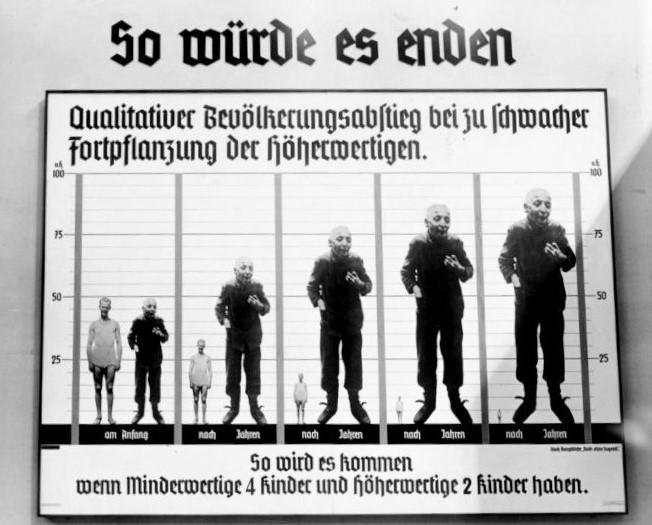ToK Exhibition: Should some knowledge not be sought on ethical grounds?
Get LOTS more help with this prompt from the e-book Should some knowledge not be sought on ethical grounds explained.
Only €5 (US$5.30) this e-book has detailed explanations of knowledge claims, and suggestions for objects that could be used.
Available for immediate download (get help now, no waiting around for email replies).
Should some knowledge not be sought on ethical grounds? - YouTube Video of this commentary linked here
Interpretation of prompt (should some knowledge not be sought on ethical grounds ?):
I interpret this prompt as asking whether there is some knowledge that we should not acquire, or produce, for ethical reasons. You may interpret it in a different way, that’s fine, just be sure to explain to the examiner at the beginning how you are interpreting it. I have seen some students who have interpreted this prompt as asking whether we have to use ethical means to acquire knowledge. That’s not how I interpret it.
Identify Knowledge arguments BEFORE the objects.
Ok - let’s work out 3 knowledge arguments to answer this prompt. I strongly recommend that students identify 3 knowledge arguments BEFORE you identify objects for the prompt - it makes the rest of the exhibition easier, and makes it more likely that you will gain high marks.
So:
Knowledge Argument 1:
Some knowledge should not be sought because seeking it will require unethical behaviours.
Knowledge Argument 2:
Some knowledge should not be sought because there is a high probability that it will be used for unethical purposes.
Knowledge Argument 3:
All knowledge, including ethical standards, is contextual, therefore there is no knowledge that should not be sought on ethical grounds.
These are just examples of knowledge questions that could be used for this IA prompt, there are many other knowledge questions that you could develop for this prompt.
Now we have our knowledge questions let’s develop each of them as an answer to the prompt. To do this we will be using the ToKToday structure that ensures that you cover all aspects of the marking rubric, increasing your chances of getting a high score in The Exhibition.
moving from real world context to knowledge arguments in ToK Exhibition
Object 1: Photo of Tuskegee University, Alabama, United States.
By Skegeepedia - Own work, CC BY-SA 3.0,
Explain link between the real world context of the object and the prompt.
Between 1932-1972 Tuskegee University, and the US Dept of Public Health, infected 399 African American men with syphilis in order to study the progression of syphilis in the men. The study is now deemed unethical as the men were not given proper treatment for their disease. Further, the researchers did not obtain informed consent from the participants, and the study potentially perpetuated harmful stereotypes about African Americans (Ogungbure).
Explain link between the object and the knowledge argument.
The aim of the Tuskegee Syphilis Study (to understand the natural progression of the disease in African American Men) would be deemed justifiable by many health professionals. However, this knowledge could have been sought using ethical means such as studying men who have contracted the disease naturally. The debate is whether the quality of knowledge produced by unethical means was significantly better than that which would have been produced using ethical means. If the knowledge produced unethically was significantly better than that produced ethically the unethical “costs” of seeking such knowledge could be justified. In some instances knowledge produced unethically can lead to greater ethical benefits than the costs of the unethical practices required to produce them. In the case of the Tuskegee Syphilis Study the knowledge gained is deemed by many researchers to not be significantly better than that which could have been gained using ethical methods (Pritchard and Goldfarb). How we determine “better” knowledge varies depending on the context, including the purpose of the knowledge, the intentions of the researcher, and methodological constraints. The context of the Tuskegee study did not require unethical practices to produce knowledge that was significantly better than that which could have been sought ethically. As such this object demonstrates that some knowledge should not be sought on ethical grounds due to unethical practices of seeking that knowledge.
Justification for inclusion in the Exhibition.
The Tuskegee study is included specifically because it demonstrates that often knowledge can be sought using ethical means rather than unethical means even if the ethical means are lengthier or more costly.
Words for object 1: 321
Object 2: Eugenics poster from Wonders of Life Exhibition, Berlin 1935.
(“Bundesarchiv Bild 102-16748, Ausstellung ‘Wunder Des Lebens’”)
Explain link between the real world context of the object and the prompt.
Object 2 is a poster shown at an exhibition in Berlin in 1935. The poster promotes human eugenics (selective breeding to increase the frequency of “desirable” characteristics). The poster shows demographic projections of the higher fertility of the "inferior" people compared to "superior" people. The poster shows that some knowledge should not be sought on ethical grounds if that knowledge will be used for unethical purposes. As such, object 2 refers to ethical grounds as the ethical principles regarding the use of knowledge.
Explain link between the object and the knowledge argument.
Much research into genetics has occurred since the Nazis were undertaking eugenics research in the 1940s. Contemporary genetics research is governed by strong ethical frameworks, including ethical codes of practice, disclosure and application, including the use of ethical boards and overseeing bodies. As such contemporary genetics research is widely deemed to be ethical, it gives us an understanding of the link between genetics and various diseases, and is used to improve human health and prolong life. However, the Nazis used the subsection of genetics research known as eugenics in order to develop a “superior” racial grouping. Their research methods involved many unethical practices including enforced sterilisation, murder of people with specific conditions, and enforced surgery.
Justification for inclusion in the Exhibition.
Object 2 is included in The Exhibition because it demonstrates that not only should some knowledge not be sought because of the methodology of seeking that knowledge, but also because of the application of the knowledge when it is produced. Contemporary genetics research (in contrast to Eugenics research) has parallels in terms of the knowledge sought, but both the methodology of seeking the knowledge, and the use of the knowledge produced, is radically different from eugenics research (Caplan et al.).
Object 2 words: 365
Object 3: Fingerprints by Francis Galton (1892)
Explain link between the real world context of the object and the prompt.
Object three is the book fingerprints by Frances Galton 1892. Francis Galton undertook the first scientific study of fingerprints as a means of identification, and was the first scientist to codify the use of fingerprints for identification. This object is linked to the prompt because Galten's work on fingerprints would be deemed unethical by today's standards and yet the knowledge is now applied for ethical purposes. As such this object demonstrates that all knowledge including ethics is contextual, and therefore open to change, and therefore no knowledge should not be sought on ethical grounds.
Explain link between the object and the knowledge argument.
In the 1890s gold Cinemas undertaking a form of eugenics research in which he was interested in the relationship between genetics and phenotypical characteristics. he undertook Mass cross cultural research. the aims, some of the practices, and the knowledge produced from this research would have be deemed unethical today. However, at the time The work was viewed as respectable and sophisticated scientific research. This shows that ethical codes and practices change in time and space.As such we could argue that we should seek knowledge regardless of current ethical beliefs as those ethical beliefs may change in the future (Galton and Galton) .
However, Galton's work gives further support for this argument because in the course of his research codified the use of fingerprints as a means of identification. This knowledge is used in such a way today that would be deemed ethical in preventing wrongdoing.
Justification for inclusion in the Exhibition.
Object 3 is included because it was the first time that fingerprints were scientifically studied to produce the knowledge for reliable identification by fingerprint. Arguably, because of Galton’s context, and the lack of prior research in this area, the study necessarily broke contemporary ethical guidelines. However, not only was the research not deemed unethical in the late 19th century, but the knowledge produced from Galton’s research is used for ethical purposes today. As such, this object supports the proposition that all knowledge should be sought regardless of the ethical grounds.
Object 3 words: 329.
Total words: 1015 (I’ve got a bit of editing to do)
Other resources available on The ToK Exhibition includes:
Key factor in ToK Exhibition: Specificity
ToK Exhibition Commentary: What counts as knowledge?
What are the Examiners thinking? (ToK Exhibition)
Bibliography.
Works Cited
“Bundesarchiv Bild 102-16748, Ausstellung ‘Wunder Des Lebens.’” Wikimedia.org, 2021, upload.wikimedia.org/wikipedia/commons/3/35/Bundesarchiv_Bild_102-16748%2C_Ausstellung_%27Wunder_des_Lebens%27_rotate_crop.jpg?20210601153422. Accessed 14 Apr. 2023.
Caplan, A. L., et al. “What Is Immoral about Eugenics?” British Medical Journal, vol. 319, no. 7220, Nov. 1999, pp. 1284–84, https://doi.org/10.1136/bmj.319.7220.1284.
Galton, D. J., and C. J. Galton. “Francis Galton: And Eugenics Today.” Journal of Medical Ethics, vol. 24, no. 2, Apr. 1998, pp. 99–105, https://doi.org/10.1136/jme.24.2.99. British Medical Journal.
Ogungbure, Adebayo. “The Tuskegee Syphilis Study: Some Ethical Reflections.” A Journal of the Philosophical Association of Kenya (PAK) New Series, vol. 3, no. 2, 2011, pp. 75–92, www.ajol.info/index.php/tp/article/view/74876/65465#:~:text=The%20Tuskegee%20Study%20raised%20a.
Pritchard, Michael, and Theodore Goldfarb. “The Tuskegee Syphilis Study | Online Ethics.” Onlineethics.org, 2000, onlineethics.org/cases/ethics-science-classroom/tuskegee-syphilis-study.
Skegeepedia. “English: Built in 1906 and Completely Renovated in 2013, Tompkins Hall Serves as the Primary Student Dining Facility and Student Center. The Building Includes a Ballroom, an Auditorium, a Game Room, a Retail Restaurant, and a 24-Hour Student Study with Healthy Food Vending Machines. It Is Home to the Offices of the Student Government Association (SGA).” Wikimedia Commons, 26 Oct. 2013, commons.wikimedia.org/w/index.php?curid=30051263. Accessed 14 Apr. 2023.






